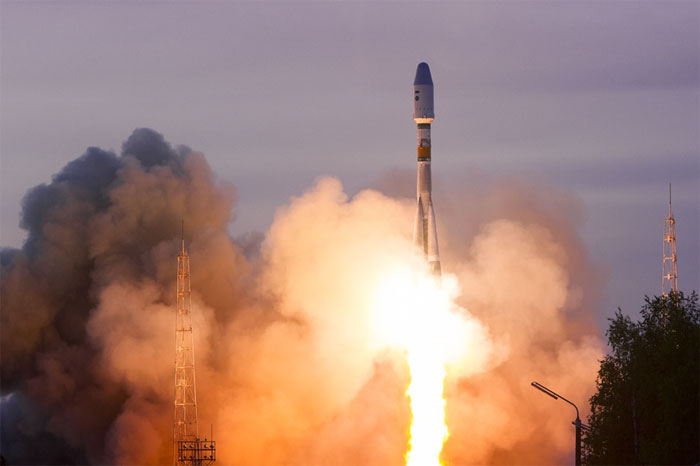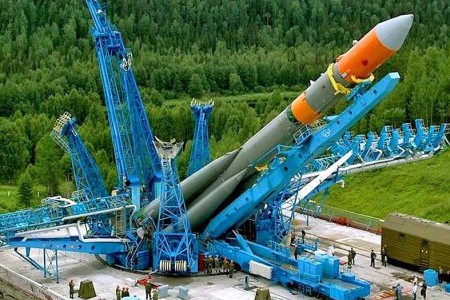.
MOSCOW, May 04 /ITAR-TASS/. A space rocket Soyuz-2.1a was delivered and put on a launching pad at northern Russia’s Plesetsk spaceport, where the launch crew will make a cycle of tests of on-board systems and units of the rocket and launching equipment, Defence Ministry’s spokesman for Aerospace Defence Troops Col Aleksey Zolotukhin told Itar-Tass.
The decision to deliver and place the launch vehicle Soyuz-2.1a on the launching pad was taken at a meeting of the state committee for flying trials of military spacecrafts which was held at Plesetsk spaceport under the chairmanship of Commander of Aerospace Defence Troops Lieutenant General Alexander Golovko on Saturday.
The launch of rocket Soyuz-2.1a with a military spacecraft is due on May 6, 2014.
Rocket Soyuz-2.1a is a modification of rocket Soyuz-2 belonging to three-stage, middle-class rockets created on the basis of rocket Soyuz-U through deep modernisation made by the Samara-based design bureau Progress. The payload weight put on the low Earth orbit ranges from 2,800 to 9,200 kilograms depending on modification and a point of launch.
Instead of two analogue control systems a unified digital control system of Russian production is mounted on Soyuz-2.1a that allows increasing sharply accuracy of orbiting, stability and controllability of the rocket. The payload put into orbit is increased thanks to larger nose fairings. Soyuz-2.1a is also equipped with a new digital radio-telemetric system.
Quelle: ITARTASS
.
Update: 6.05.2014
.
Soyuz 2-1A successfully Launches Kobalt-M Reconnaissance Satellite

A Russian Soyuz 2-1A rocket lifted off from the Plesetsk Cosmodrome’s Site 43/4 on Tuesday at 13:49 UTC carrying the ninth Kobalt-M optical reconnaissance spacecraft to orbit. According to ITAR-TASS, the launch was successful and Kobalt-M was delivered to its planned Low Earth Orbit from where it will operate for up to five months.
Kobalt-M spacecraft are film-return satellites that capture images of targets on physical film that is returned to Earth by three re-entry vehicles for post-flight analysis.
Although Russia has begun the operation of large high-resolution electro-optical spacecraft that acquire digital images for downlink to the ground, the Kobalt-M series has continued operation with one launch per year because it is considered a reliable and cheap source of satellite imagery. Over the coming years, Kobalt-M will be retired and replaced by modern imaging satellites such as Persona and Bars-M.
Tuesday’s launch from Plesetsk was preceded by the nominal eight-hour countdown sequence of the Soyuz that started with final tanking preparations, checkouts of the various launch vehicle systems and the removal of protective covers from the launcher. Four hours ahead of the flight, the Soyuz began propellant loading, being filled with a total of 274,140 Kilograms of rocket-grade Kerosene and –183°C Liquid Oxygen. After fueling, teams closed out the launcher and its pad for the liftoff, loaded the flight software into the flight control system of the Soyuz and performed a final set of tests of the vehicle. The protective Service Structure was removed about 45 minutes before launch.
Heading into the Terminal Countdown Sequence six minutes before liftoff, Soyuz pressurized its propellant tanks, purged its engines, switched to onboard power and assumed control of the countdown with its own computers ahead of the start of the ignition sequence at T-20 seconds.
The 308,000-Kilogram Soyuz 2-1A blasted off from Site 43/4 at 13:49 UTC on Tuesday embarking on a short flight into Low Earth Orbit. The mission was a direct insertion into LEO, no upper stage was installed on the Soyuz launcher.
With a liftoff thrust of 424,900 Kilograms, the Soyuz ascended into the Russian sky being powered by its four boosters and their RD-117 engines along with the RD-118 of the core stage. Ascent performance was nominal and after two minutes, the four strap-on boosters were jettisoned when their job of providing extra-thrust for the initial portion of the flight was done.
The Core Stage continued to power the vehicle providing 999.6 Kilonewtons of vacuum thrust. After burning more 98,525kg of propellants, the Core Stage separated at T+4:47 and the third stage was in charge of powering the vehicle for about four minutes using its RD-0110 engine delivering a thrust of 297.9 kN. On its way uphill, the Soyuz jettisoned its payload fairing, exposing the 6,600-Kilogram Kobalt Satellite on its way into orbit.
Following its basic mission profile, the Soyuz 2-1A fired its third stage for just under four minutes to reach a Low Earth Orbit. The target orbit for this Kobalt-M mission was not disclosed, however the most recent Kobalt-M launch from 2012 can serve as a reference having targeted an orbit of 190 by 255 Kilometers.
Spacecraft separation occurred just shy of T+9 minutes and the launch was declared a success. It was the ninth Kobalt-M to be launched likely with one more to follow in 2015 before the retirement of the project.
Quelle: SF101



